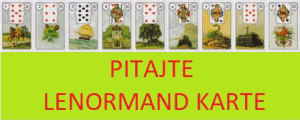A Curriculum for Cybernetics and Systems Theory
Alan B. Scrivener
abs@well.com
FIRST DRAFT
(c) 1 March 1990 by Alan Scrivener
SECOND DRAFT
(c) 22 August 2002 by Alan Scrivener
MINOR EDITS
(c) 4 March 2012 by Alan Scrivener
New! Beginning in September 2002, I will be sharing a free e-Zine, "Cybernetics in the Third Millenium" (C3M), about 1,000 - 18,000 words per issue and about one isssue every other month. If you are interested in a free subscription to this electronic newsletter, please email abs@well.com with C3M in the subject.
Note:
Albert Ward of Plovdiv, Bulgaria, has graciously done the work to translate this document into Bulgarian.
(
www.fatcow.com/edu/well-curriculum-bl )CONTENTS
Introduction
What This Is
Cybernetics and Systems Theory Defined
Why We Need Cybernetics and Systems Theory Now
Where Cybernetics and Systems Theory Came From
How I Got Into Cybernetics and Systems Theory
Format
Books
Multi-Valued
Bateson
Cybernetics
Systems Theory
Psychology
Biology
Sociology
Ecology
Chemistry
Physics
Information Science
Television
Periodicals
Software
Action
Write Your Onw Software
Fantasy, Role Playing and Simulation Games
Field Work
Solving Real Problems
Feedback Requested
INTRODUCTION
What This Is
This is a list, with reviews, of suggested books, periodicals, television shows and computer programs for a classroom curriculum or individual study in cybernetics and systems theory. It does not (yet) include a course plan, glossary, or extended bibliography. I was asked to write this by some teachers who received a copy of class notes I prepared for a course in "Understanding Whole Systems" sixteen years ago at the University of California at Santa Cruz. They asked how I would revise it based on what I know today. This document answers that question.
[A similar web site exists at the Principia Cybernetica Project. - ABS 8/11/96]
Cybernetics and Systems Theory Defined
Right off, let's dispense with the childish belief that words "have" meanings. Charles Dodson / Lewis Carroll was close to the mark with this dialogue between Alice and Humpty Dumpty:
Humpty Dumpty: [Having just proved it is 364 times better to celebrate
your un-birthday] There's glory for you!
Alice: I don't know what you mean by 'glory.'
Humpty Dumpty: Of course you don't -- 'till I tell you. I meant
'there's a nice knock-down argument for you!'
Alice: But 'glory' doesn't mean 'a nice knock-down argument.'
Humpty Dumpty: When I use a word, it means just what I choose it to
mean -- neither more nor less.
Alice: The question is whether you can make words mean so many
different things.
Humpty Dumpty: The question is which is to be the master -- that's all.
A lot of time has been wasted arguing over what the terms cybernetics and systems theory "really" mean. Rather than add to the muddle, let me just define them, and some other related concepts, the way I mean them and leave it at that.
Information is "a difference that makes a difference," to use Gregory Bateson's definition. It is a measure of the reduction of uncertainty (entropy) that results from receiving a message. The term was rigorously defined by Claude Shannon of Bell Labs in 1950. Its unit is the bit, which is the amount by which your uncertainty is decreased when you find out that something happened which had a probablity one half. The bit measures in units of the minus the log to the base two of probablity: -log2(p) By this definiton news that of event which had a probablity of one fourth yields two bits of information, news that of event which had a probablity of one eighth yields three bits of information, and so on.
System is a word that we use to describe any "experience-cluster" that we can map as a set of interacting elements over time. Typically a system is mapped by identifying the pathways of information flow -- as well as possibly the flow of energy, matter and other variables. But the "flow" of information is special, because only information can go from A to B while also staying at A. (Consider that photocopy machines would be useless if you didn't get to keep your original.)
Cybernetics is the study of systems which can be mapped using loops (or more complicated looping structures) in the network defining the flow of information. Systems of automatic control will of necessity use at least one loop of information flow providing feedback. (Appropriately the word cybernetics is derived from the Greek for "pilot," as in "auto pilot" and "pilot light.") The word was first coined in 1945 by Nobert Wiener in the book Cybernetics (listed below), in which he defined it as "the study of control and communication in the animal and the machine." Gregory Bateson clarifies the methodology in "Cybernetic Explanation" (one of the essays in the book Steps to an Ecology of Mind, listed below.) In a nutshell, he says:
Causal explanation is usually positive. We say that billiard ball B moved in such and such a direction because billiard ball A hit it at such and such an angle. In contrast to this, cybernetic explanation is always negative. We consider what alternate possibilites could conceivably have occurred and and then ask why many of the alternatives were not followed, so that the particular event was one of the few which could, in fact occur...
In cybernetic language, the course of events is said to be subject to restraints, and it is assumed that, apart from such restraints, the pathways of change would be governed only by equal probability.
Systems theory is the study of systems which can be mapped using any kind of network to define the flow of information. This includes the study of systems whose emergent properties we cannot yet predict due to a lack of plausable mechanisms, rigorous mapping techniques and/or robust mathematical treatment. By these definitions systems theory includes and is more abstract than cybernetics. In General System Theory (listed below), Ludwig Bertalanffy draws this distinction:
Cybernetics is a theory of control systems based on communication (transfer of information) between systems and environment and within the system, and control (feedback) of the system's function in regard to environment... The model is of wide application but should not be identified with "systems theory" in general.
... Cybernetic systems are a special case, however important, of systems showing self-regulation.
Whatever distinctions you draw, what I am aiming at is the study of properties that emerge from the interconnectedness and complexity of relationships between parts.
Why We Need Cybernetics and Systems Theory Now
"When we try to pick up anything by itself
we find it is attached to everything in the universe."
-- John Muir
I keep having this image of a survey course in human physiology, in which the syllabus covers each body system in turn, and in the final week it is all put together into a whole person. But, as the semester drags on the instructor gets behind in the material, until suddenly it is time for finals and the integrative material has not been covered. "Well," says the teacher, "I will leave it to the more ambitious students as an extra credit project."
I see this as a metaphor for what is wrong with our educational system, and the body of knowledge on which it is based: we have great methods for taking things apart and analyzing them, but the problem of putting them back together is trivialized even though it is unsolved. If Western Civilization's science, religion, philosophy and epistemology were in better shape (more mature?), we would not need cybernetics and systems theory as separate areas of inquiry; they would be woven into the fabric of our knowledge as already are other prior mental tools such as: the flexibility of language, the rigor of linear algebra, and the etiquette of professional communication. But instead our tradition of education has a blind spot when it comes to complexity, interconnectedness and relationship, and properties that emerge from them.
This might all seem like abstraction of abstraction, some kind of "airy fairy" diversion of language, except that the results are vital to questions of survival. As columnist Ellen Goodman pointed out about health research (LA Times 5/26/87): "There's a tendency to study single diseases and small body parts instead of lives. The group concerned with the maintenance of lungs doesn't always 'do' ankles and the cancer- prevention team isn't 'into' cardiovascular diseases. As the last generalists, we, the owners of whole bodies, are supposed to think of ourselves as nothing more than the sum of parts and potential diseases to be taken care of with separate regimens." [Emphasis mine.] Or, as a Buddhist baker once said, "We're all in this alone." We each face the integration of life, the universe and everything with few really useful clues from our mainstream culture and educational systems.
The blind spot in our civilization when it comes to wholeness and loops goes back a long way. Plato said, in Georgics, that "Helmsmanship is unassuming and modest and does not boast and does not behave as if it had done something wonderful." This contempt for piloting fits in with the general ancient Greek aversion to any linking truth-seeking with useful activity. This meant the literate philosophers and the skilled workers were kept apart. The Romans were by contrast ruthlessly practical, had literate engineers (who could write down their skills and plans). They conquered the known world with their "practicality," which had toxic social, religious and ecological side effects. Christinanity swept the Roman empire partially as an antidote to the Roman toxic pragmatism. The dark ages were, in Europe, a period of avoidance of practical applications of technology in favor of the search for religious grace. Our civilization didn't deviate from this pattern until the 13th Century, when literate monks were forced to garden, and dragged out a bunch of Roman engineering books, rediscovering hydraulics and inventing the windmill. Similar integrations of learning and labor helped bring about the Renaissance and the Industrial Revolution. And yet today we call schools where more practical skills are taught "Junior Colleges," while all the really useless ideas are confined to "Universities." Greek logic was made symbolic by nineteenth century academic George Boole, who -- like the Greeks -- prohibited loops in logic chains. But in this century electronic engineers found that you can build logic gates physically, and you can hook them up in loops, resulting in both digital memories and digital oscillators. These humble engineers were "off the map" of Western civilization's mathematics and philosophy. One of the simplest of these circuits was a one-bit memory, which was named a "flip flop" -- indicating the lack of academic tradition for the whole idea.
Our traditions cling to the idea that explanations can be built of short causal chains: event A causes event B, which causes event C. Loops are prohibited because they are hard to analyze, introducing non-linear terms into the equations. Therefore our current scientific method has become a form of pretend madness in which we deny that anything is connected to anything else unless we can prove that it is. We use this method because we can so much more easily start with assumed isolation and then prove the connectedness of the components of a system than do the opposite. But our simplifying assumption has become an article of faith, and this false faith is aggravating the "externalities" of our society: pollution, crime, alienation, illiteracy, the decay of our infrastructure, the decline of our industry. All of these problems have been amplified by the success of our technology in achieving narrowly defined goals. Cybernetics and systems theory are part of the antidote to the toxic byproducts of our short-sighted reductionism.
Where Cybernetics and Systems Theory Came From
"What is a man, that he may know a number,
or a number, that a man may know it?"
-- Warren McCulloch
In 1868 James Clerk Maxwell (author Maxwell's equations of the electrodynamics, and inventor of the mental construct Maxwell's Demon) was invited by steam engineers to help them figure out why the governors on their engines didn't always work right: sometimes the steam engines exploded. Maxwell analyzed the "steam-engine-with- governor under a changing load" as a system of non-linear differential equations, and concluded the system would do one of five things based on the coefficients of the equations. (1) It corrected the speed back to the desired level fairly smoothly (the most desired response):
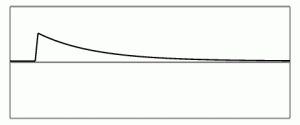
Or (2) it corrected the speed back to the desired level after some overshoot (also a desired response):
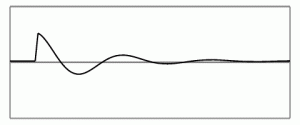
Or (3) it oscillated continuously -- an annoying and inefficient repsonse later called "hunting" in the 1930's by electronics researches (actually this behavior was not explicitly described by Maxwell, probably because it is unstable, but it is implicit in his analysis):
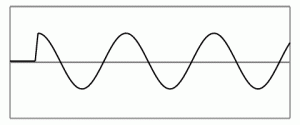
Or (4) it oscillated with increasing amplitude until it blew up (also sometimes called "hunting":
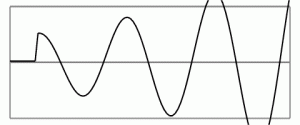
Or (5) it just blew up:
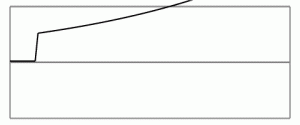
This was the first explicitly cybernetic analysis of a system I can find. Thanks to it the engineers were able to design their governors so that the steam engines didn't explode so often. The governor became a metaphor for some 19th century visionaries: Samuel Butler in Erewhon predicted thinking machines evolving out of governors, and Alfred Russell Wallace came up with the idea of evolution by natural selection -- independently from Darwin -- when he realized that adaptive restraints operated like a governor on a steam engine.
By the 1930's, when electronics was still young, electrical network theory had developed, and the select few who studied it began to understand self-correcting systems. Doctors also tended to gain this intuition, and in 1932 physician Walter Cannon in The Wisdom of the Body coined the term homeostasis to describe this phenomenon.
By the late 1940's, thanks mostly to the growth of electronics, a lot of people were running around with the idea that "feedback" was somehow important. One of them was Warren McCulloch, a pioneer brain researcher who first proposed the mathematical modeling of neurons. He was approached by the Macy Foundation to chair a conference on the nervous system. The Macy Foundation, funded by the family that ran Macy's department store (and its famous Thanksgiving Day parade), funded conferences on medicine; they had done the heart, lungs, skin, etc. but never the brain or nerves. But McCulloch was determined to make these meetings more than a typical medical conference. He invited physiologists, electronics specialists, mathematicians, physicists, even social scientists -- including husband and wife anthropologists Gregory Bateson and Margaret Mead. The participants met for a few days every six months over a period of several years. At first McCulloch only let the "neuro" people talk; he wanted everyone to understand the great questions facing them before they started looking for answers. But eventually a cautious collaboration developed, as the participants probed their intuition of what was missing from their knowledge of minds.
In 1948 one of the attendees, mathemetician Norbert Wiener, published a book in which he purported to name the new field of inquiry they were investigating: Cybernetics was the name of the field and the book. This move received mixed reviews from the other participants in the conference. However, many of the attendees did return to their disciplines and begin using the new set of tools provided by the conference, and by Wiener (including two who I had the good fortune to meet and study under: Gregory Bateson and Heinz von Foerster).
Meanwhile, in Germany, Ludwig von Bertalanffy began publishing papers on the theory of general systems, in which he (prophetically in many cases) laid down some of the criteria of such a theory. He pointed out that the fundamental tool of general systems theory was the system of differential equations, but any such set of equations robust enough to describe non-trivial systems was unsolvable. Therefore, intuition and computer simulation should play important roles in a theory of complex systems. But his work had little impact initially.
In 1950 Shannon and Weaver at Bell Labs published their first paper on what has been called "information theory" and "communication theory," but I would prefer to call "transmission theory." It is the study of how to get bits reliably over an unreliable channel -- a topic of great interest to Bell Telephone at that time. In academia this work eclipsed cybernetics, probably because it was less intellectually threatening; cybernetics advocated connecting outputs to inputs, which had been forbidden since the ancient Greeks, while information theory dealt with the familar model of:
+-------+ +---------+ +--------+
| INPUT |---->| PROCESS |---->| OUTPUT |
+-------+ +---------+ +--------+
Also, it didn't help that the popular press picked up and began to abuse the word "cybernetics," as if it meant "the study of computers, robots, and electronic gizmos," or that the book Psycho-Cybernetics was published by plastic surgeon Maxwell Maltz in 1960; it was a useful pop-psychology self-help book about auto-suggestion, but had little to do with cybernetics.
With the advance of digital computers in the 50's and 60's, the field of "information science" was heralded, which included the study of computer languages and their compilers, as well as Shannon's work. But cybernetics mostly suffered benign neglect by information science departments. By way of an example, in 1966 Scientific American published an entire issue devoted to the new technology of information, and later re- issued it as one of their theme paperbacks, called Information. Every diagram in this book has the same structure as the one above: INPUT, PROCESS, OUTPUT.
Yet, while the so-called information scientists ignored cybernetics (which they could because they designed systems and were free to design them without feedback), those scientists investigating the biochemistry of cell metabolism, the principles of nervous systems, and the population biology of ecologies (all pre-existing systems) were drawn to cybernetics because it offered more accurate models of the systems they were studying.
Some progress was made by topologists in the late 60's in classifying systems in terms of all possible behaviors they could exhibit. Initially this work, called the theory of dynamical systems, simply refined the distinctions drawn by Maxwell's governor paper.
The biggest methodological barrier to the advance of cybernetics in the 50's and 60's was the expense of computer time. But in the 70's pocket calculators became affordable, and it was on such a calculator that some of the earliest examples of chaos were discovered. This term is not used here in the every-day sense, but to describe a fifth category of system behavior besides the four illustrated above: non- periodic deterministic behavior. The discoveries of chaos, along with increasingly available computer power, sparked a renaissance of interest in cybernetics and systems theory in the late 80's.
Won't it be exciting to see what the 90's will bring?
How I Got Into Cybernetics and Systems Theory
"Watch out -- you might get what you're after."
-- David Byrne, 1983
"Burning Down the House"
In the fall of 1969, while a Junior in high school in southern California, I got my hands on an early Whole Earth Catalog. I was attracted to it because the title sounded integrative, and sure enough the first section was entitled Understanding Whole Systems. Here I was exposed to the ideas of Bucky Fuller, Norbert Wiener, Marshall McLuhan, and Paul Ehrlich. I went to a college where I could design my own major program (University of California at Santa Cruz, Kresge Collge), and searched for three years for a faculty member who would sponsor my major in "Understanding Whole Systems." Dr. Gregory Bateson arrived at Kresge in the fall of 1973, and I had even studied his English accent for a school play, but it wasn't until he was featured on the first page of the Understanding Whole Systems section of the new Whole Earth Epilog in summer of 1974 that I realized he was who I had been looking for. Starting in my senior year I took all of his classes, and he sponsored a student-directed seminar which I taught in early 1975 on Understanding Whole Systems. I'd planned to extend this activity into my major program, but I too quickly reached the end of my senior year, I hadn't met the university breadth requirements to graduate, and I was out of scholarship money.
Also in my senior year I met Dixie. We dropped out of school and bicycled across America together in 1976-77. On this journey I discovered that poverty was a real danger in an unplanned life -- a lesson that had escaped me both while growing up in suburbia and while attending a Liberal Arts university -- so upon our return from this trip I earned money and got a new scholarship so I could go back to school. I proposed marriage to Dixie, and I switched my major to Information Sciences in hopes of being more employable. Sure enough, after six months of school in 1977, at the dawn of the Personal Computer revolution I got my first job in computers, even though I had not studied Info Sci long enough to get a degree. We wed and moved from northern California to Massachusetts.
For a decade I rode the computer wave, letting my interest in whole systems be a hobby on my back burner. About the only thing I did to keep this interest alive to was to occasionally visit libraries on the Dewey Decimal System and scan the shelf that started with 000. This is where all the books on cybernetics, systems theory, theory of knowledge, philosophy of science, library science, management science, ESP, flying saucers, witchcraft and Atlantis may be found.
By 1987 I was a computer graphics programmer for the NASA Space Station project at Rockwell International in southern California, which was exciting work until Rockwell lost the Space Station contract. In casting about for a new challenge I fell into working for a company (currently named Stardent Computer Inc.) which manufactures Graphics Supercomputers. Now it so happens that the users of these kind of computers are people who need extremely high-speed computation combined with interactive graphics, and most people who fit that description are doing scientific research using a new methodogy called numerical simulation. And this methodology is on the forefront of systems theory. So I find that I am reaping the dual bonus that my hobby is useful in my job, and my job gives me opportunities to expand my understanding of my hobby.
As I explained above, some teachers recently received, through a mutual friend, a copy of my class handouts from that course in "Understanding Whole Systems" which Bateson sponsored me in teaching sixteen years ago at the University of California at Santa Cruz (UCSC). They asked how I would revise those notes based on what I have learned in the intervening years. I am happy to answer that question.






















































 bglavac
bglavac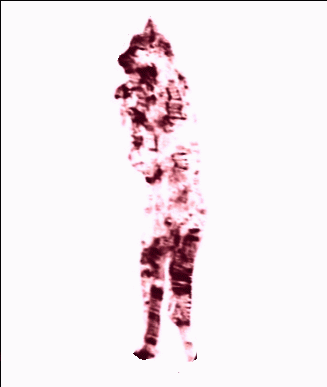 edin.kecanovic
edin.kecanovic irida
irida



































